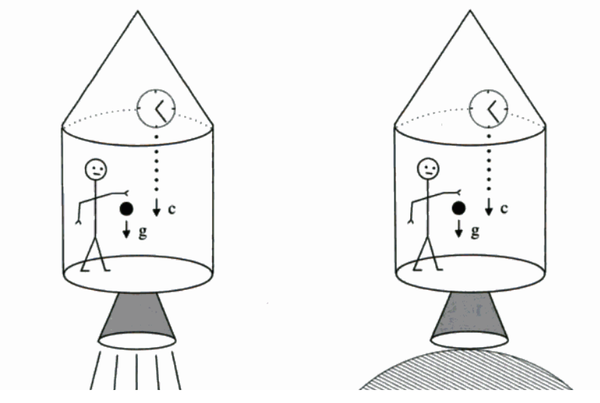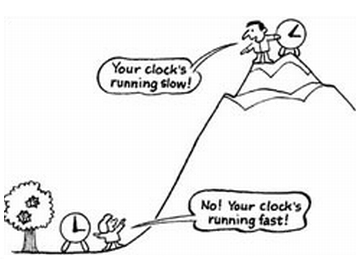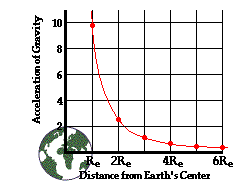Difference between revisions of "Gravitational Time Dilation"
Tom Bishop (talk | contribs) |
Tom Bishop (talk | contribs) |
||
| Line 107: | Line 107: | ||
In the above we saw that a clock on Earth was compared to a clock raised to an elevation of 6200 miles, concluding that the time dilation experienced confirmed the effect that would happen in a 'uniform gravitational field', per the Equivalence Principle. | In the above we saw that a clock on Earth was compared to a clock raised to an elevation of 6200 miles, concluding that the time dilation experienced confirmed the effect that would happen in a 'uniform gravitational field', per the Equivalence Principle. | ||
| − | According to a Physics Classroom article on gravitational theory, gravity diminishes significantly in that range. With an Earth with a supposed radius (R) of 3,958.8 miles, at 2R from the center of the Earth, at 3,958.8 miles above the earth's surface, the value of gravity is much different. | + | According to a Physics Classroom article on gravitational theory, gravity diminishes significantly in that range. With an Earth with a supposed radius (R) of 3,958.8 miles, at 2R from the center of the Earth, at a position of 3,958.8 miles above the earth's surface, the value of gravity is much different. |
https://www.physicsclassroom.com/class/circles/Lesson-3/The-Value-of-g | https://www.physicsclassroom.com/class/circles/Lesson-3/The-Value-of-g | ||
Revision as of 21:54, 21 July 2021
Gravitational time dilation is a phenomenon in which the difference of elapsed time manifests between two events as measured by observers situated at varying distances from the Earth. Time is seen to dilate in accord with the Equivalence Principle, which predicts that all physical effects which would occur in an upwardly accelerating rocket ship should also happen in a gravitational field. Since the time dilation of clocks would occur at different elevations inside of an upwardly accelerating rocket, it must occur at different elevations in the Earth's gravitational field as well. Supposedly only a 'local' effect, the Equivalence Principle and its uniform nature[1] has been confirmed over various elevations.
Description
From p.8 of Cosmological Physics (Archive) by John A. Peacock, PhD. (bio) we read the following:
GRAVITATIONAL TIME DILATION
“ Many of the important features of general relativity can be obtained via rather simple arguments that use the equivalence principle. The most famous of these is the thought experiment that leads to gravitational time dilation, illustrated in figure 1.1. Consider an accelerating frame. which is conventionally a rocket of height h, with a clock mounted on the roof that regularly disgorges photons towards the floor. If the rocket accelerates upwards at g, the floor acquires a speed v = gh / c in the time taken for a photon to travel from roof to floor. There will thus be a blueshift in the frequency of received photons, given by Δv / v = gh / c^2, and it is easy to see that the rate of reception of photons will increase by the same factor.
Now, since the rocket can be kept accelerating for as long as we like, and since photons cannot be stockpiled anywhere, the conclusion of an observer on the floor of the rocket is that in a real sense the clock on the roof is running fast. When the rocket stops accelerating, the clock on the roof will have gained a time Δt by comparison with an identical clock kept on the floor. Finally, the equivalence principle can be brought in to conclude that gravity must cause the same effect. Noting that ΔΦ = gh is the difference in potential between roof and floor, it is simple to generalize this to Δt / t = ΔΦ / c^2 ”
“ Figure 1.1. Imagine you are in a box in free space far from any source of gravitation. If the box is made to accelerate ‘upwards’ and has a clock that emits a photon every second mounted on its roof, it is easy to see that you will receive photons more rapidly once the box accelerates (imagine yourself running into the line of oncoming photons). Now, according to the equivalence principle, the situation is exactly equivalent to the second picture in which the box sits at rest on the surface of the Earth. Since there is nowhere for the excess photons to accumulate, the conclusion has to be that clocks above us in a gravitational field run fast. ”
Small Scale Experiments
Ultra-precise atomic clocks have confirmed that time dilates at different elevations on a personal scale.
NIST Pair of Aluminum Atomic Clocks Reveal Einstein's Relativity at a Personal Scale (Archive)
“ BOULDER, Colo. – Scientists have known for decades that time passes faster at higher elevations—a curious aspect of Einstein's theories of relativity that previously has been measured by comparing clocks on the Earth's surface and a high-flying rocket.
Now, physicists at the National Institute of Standards and Technology (NIST) have measured this effect at a more down-to-earth scale of 33 centimeters, or about 1 foot, demonstrating, for instance, that you age faster when you stand a couple of steps higher on a staircase.
Described in the Sept. 24 issue of Science,* the difference is much too small for humans to perceive directly—adding up to approximately 90 billionths of a second over a 79-year lifetime—but may provide practical applications in geophysics and other fields.
Similarly, the NIST researchers observed another aspect of relativity—that time passes more slowly when you move faster—at speeds comparable to a car travelling about 20 miles per hour, a more comprehensible scale than previous measurements made using jet aircraft. ”
Paper: Optical Clocks and Relativity (Archive)
Mt. Lemmon
Atomic clocks were compared between locations at the bottom and the top of a mountain, confirming the dilation of time.
Project GREAT 2016a -- Hawking, Einstein, and Time Dilation on Mt Lemmon (Archive)
“ Conceptually, the experiment is very simple. We take one accurate clock the top of the mountain and we take another accurate clock to a hotel at the base of the mountain and let them sit there for a day. Then we bring the clocks together again and compare. If time dilation is false then the clocks should still agree. If time dilation is real then we would expect the clock that was at the hotel to be a little behind the clock that was at the summit. ”
“ At a minimum two clocks are needed, but having multiple clocks and redundant power greatly reduces chances of failure. All six were synchronized and carried in my car for a couple of days. Then we left 3 of them at the top of the mountain, storing them in the astronomer's dormitory, and kept the other 3 in the car as we drove back down to a hotel in Tucson. We waited a day, and then drove back up and compared the clocks.
The elevation of the clocks at the hotel was 775 m (about 2540 feet) and the elevation of clocks at the summit was 2780 m (about 9120 feet). So the difference in elevation was 2.00 km (about 6580 feet). The length of time the clocks were separated was about 23 hours. The formula gh/c² predicts a time dilation of about 18 ns (nanoseconds).
Now, these clocks are not without error. Even atomic clocks are not perfect. But they are extremely well-designed, and they were all tested prior to the experiment, and found to have a timing error of approximately ± 2 ns per day. Since we are comparing imperfect clock(s) at the base with imperfect clock(s) at the summit the experiment has some inherent error. The key is to design the experiment so that the effect being measured (gravitational time dilation) is at least ten times greater than the inherent fluctuations in the clocks themselves.
In general, the higher you go, the longer you stay, the better the clocks, the more clocks you use, then the more certain the results will be. In this experiment the (preliminary) measured value of 21 ns is within expectations and close to the predicted value of 18 ns. So Hawking is genius, Einstein is happy, time dilation is real, PBS got quality footage, and a good time was had by all. ”
Similar Experiments
A similar experiment showing time dilation on a mountain was conducted in 1977 by Briatore and Leschiutta to about 11,500 feet on Plateau Rosa, afferming that the effect meets the principle of equivalence.
Ballistic Rocket
According to the mainstream narrative it is claimed that in 1976 the Smithsonian Astrophysical Observatory and the National Aeronautics and Space Administration engaged in a joint project to test the Equivalence Principle by comparing the difference of time dilation at high altitudes and the surface of the earth. A ballistic (sub-orbital) rocket was sent to an altitude of 6,200 miles on an elliptical trajectory over the Atlantic Ocean before falling back down to earth. At a great height an atomic clock on board the rocket was compared to an atomic clock on the surface of the earth, confirming that time dilates in accordance with the uniform nature of the Equivalence Principle.
http://research.omicsgroup.org/index.php/Gravity_Probe_A (Archive)
Gravity Probe A
“ Gravity Probe A (GP-A) was a space-based experiment to test the equivalence principle, a feature of Einstein's theory of relativity. It was performed jointly by the Smithsonian Astrophysical Observatory and the National Aeronautics and Space Administration. The experiment sent a hydrogen maser, a highly accurate frequency standard, into space to measure with high precision the rate at which time passes in a weaker gravitational field.
~
The experiment was a test of a major fallout of Einstein's general relativity, the equivalence principle. The equivalence principle states that a reference frame in a uniform gravitational field is indistinguishable from a reference frame that is under uniform acceleration. Further, the equivalence principle predicts that phenomenon of different time flow rates, present in a uniformly accelerating reference frame, will also be present in a stationary reference frame that is in a uniform gravitational field.
~
The probe was launched on June 18, 1976 from the NASA-Wallops Flight Center in Wallops Island, Virginia. The probe was carried via a Scout rocket, and attained a height of 10,000 km (6,200 mi), while remaining in space for 1 hour and 55 minutes, as intended. It returned to Earth by splashing down into the Atlantic Ocean.
~
The objective of the Gravity Probe A experiment was to test the validity of the equivalence principle. The equivalence principle was a key component of Albert Einstein's theory of general relativity, and states that the laws of physics are the same regardless of whether you consider a uniformly accelerating reference frame or a reference frame that is acted upon by uniform gravitational field.
The equivalence principle can be understood by picturing a rocket ship in two scenarios. First, imagine a rocket ship that is at rest on the Earth's surface; objects in the rocket ship are being accelerated downward at 9.81 m/s². Now, imagine a rocket ship that has escaped Earth's gravitational field and is accelerating upwards at a constant 9.81 m/s² due to thrust from its rockets; objects in the rocket ship that are dropped will fall to the floor with an acceleration of 9.81 m/s². This example shows that a uniformly accelerating reference frame is indistinguishable from a gravitational reference frame.
~
The 100 kg Gravity Probe A spacecraft housed the atomic hydrogen maser system that ran throughout the mission. Maser is an acronym for microwave amplification by stimulated emission of radiation, and is similar to a laser, as it produces coherent electromagnetic waves in the microwave region of the electromagnetic spectrum (as opposed to lasers which produce light in the visible or ultraviolet region). The probe was launched nearly vertically upward to cause a large change in the gravitational potential seen by the maser, reaching a height of 10,000 km (6,200 mi). At this height, relativity predicted a clock should run 4.5 parts in 1010 faster than one on the Earth.
~
The experiment was thus able to test the equivalence principle. Gravity Probe A confirmed the prediction that deeper in the gravity well the time flows slower,[4] and the observed effects matched the predicted effects to an accuracy of about 70 parts per million. ”
Uniform Gravitational Field
Additional reference to the 'uniform gravitational field' of the Equivalence Principle can be seen on p.8 of How The Universe Works: Introduction To Modern Cosmology (Archive):
“ The Gravity Probe A experiment also confirmed another important General Relativity effect: the equivalence principle, which states that the object behaves the same regardless of whether it is uniformly accelerating or placed in a uniform gravitational field. ”
Elliptical Trajectory
Aeronautics and Space Report of the President - 1976 Activities (Archive) contains reference to the device's elliptical flight over the Atlantic Ocean:
June 18 - Gravity Probe A (Red Shift Experiment) - sub-orbital - Scout
“ Objective: To test Einstein’s "equivalence principle," which is the foundation of relativity theory.
Probe: 114-cm long. 96-cm diameter; extremely accurate hydrogen maser atomic clock: support equipment consists of S-band telemetry transponder, battery, and cooling system. Weight: 102kg
Remarks: Launched by NASA into an elliptical flight of one hour and 55 minutes over Atlantic Ocean. Maximum altitude 10,000 km. Data substantially confirmed equivalence aspect of the theory. ”
Physics Classroom
In the above we saw that a clock on Earth was compared to a clock raised to an elevation of 6200 miles, concluding that the time dilation experienced confirmed the effect that would happen in a 'uniform gravitational field', per the Equivalence Principle.
According to a Physics Classroom article on gravitational theory, gravity diminishes significantly in that range. With an Earth with a supposed radius (R) of 3,958.8 miles, at 2R from the center of the Earth, at a position of 3,958.8 miles above the earth's surface, the value of gravity is much different.
https://www.physicsclassroom.com/class/circles/Lesson-3/The-Value-of-g
Addendum
The experimental claims of mainstream science demonstrate that there is difficulty with finding violations of the Equivalence Principle. Experiments with very sensitive equipment show that the uniform nature of the EP is verified to various elevations. If it is claimed that there are variations in gravity, one should be able to directly reference the empirical experiments which show these variations, rather than merely claim or assert that they exist based on rumor or theory.
The few referenced experiments from science history which do claim slight variations of gravity are seen to be conducted in uncontrolled settings (See: Weight Variation by Latitude). Weight is also affected by factors outside of 'gravity'. It is also related to a buoyancy related to pressure, humidity, air viscosity, temperature, etc, which exist differently in different locations, and which may contribute in complex ways to the readings of the scale. Such experiments must necessarily be controlled from all other known factors which affects the scale, ideally conducted in a vacuum chamber. Experimental evidence otherwise shows resounding agreement with the concept that our Earth is accelerating upwards.
See Also
Time Dilation Topics
- Time Dilation by Latitude - Time does not dilate at different latitudes as predicted due to the rotation of Earth
Flat Earth Gravity Topics
- Universal Acceleration - The Universal Accelerator Main Page
- Equivalence Principle - Gravity behaves as if the Earth is accelerating upwards
- Evidence for Universal Acceleration - Experiments and background foundation showing that Earth is accelerating upwards
- Variations in Gravity - Various experiments have failed to find variations in gravity or violations of the Equivalence Principle
- Gravitational Time Dilation - Time dilates in accordance with the uniform prediction of the Equivalence Principal to various heights
Round Earth Gravity Topics
- Weight Variation by Latitude - An uncontrolled weight change experiment which is not performed in a vaccum chamber
- Cavendish Experiment - An inconsistent short range attraction experiment
- Gravimetry - Gravimeters are described to be seismometers by mainstream sources
- Isostasy - The mass attraction of mountains and continents does not behave in accordance with 'gravity'



